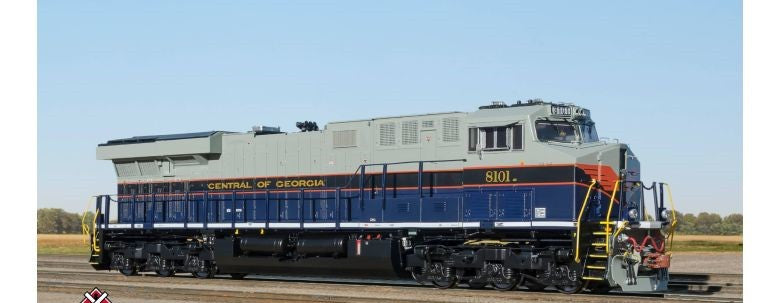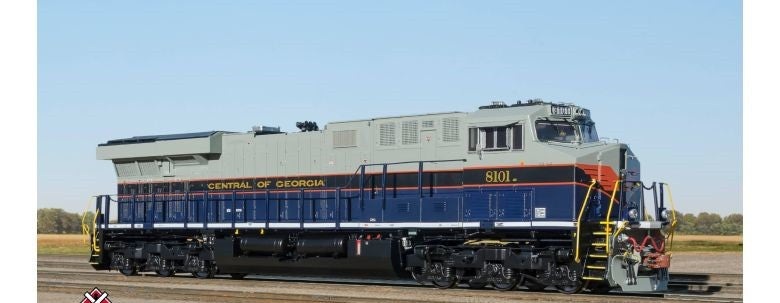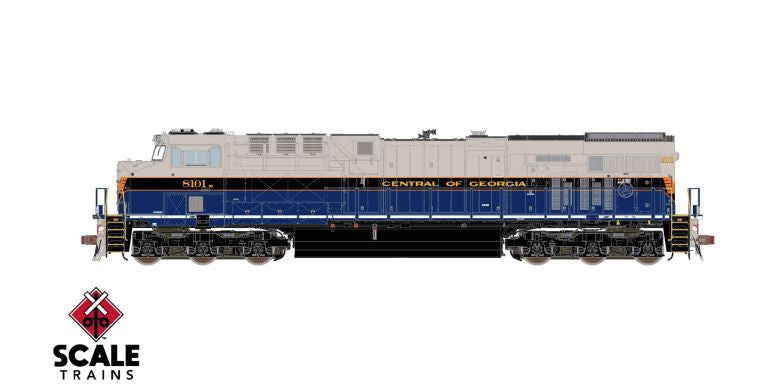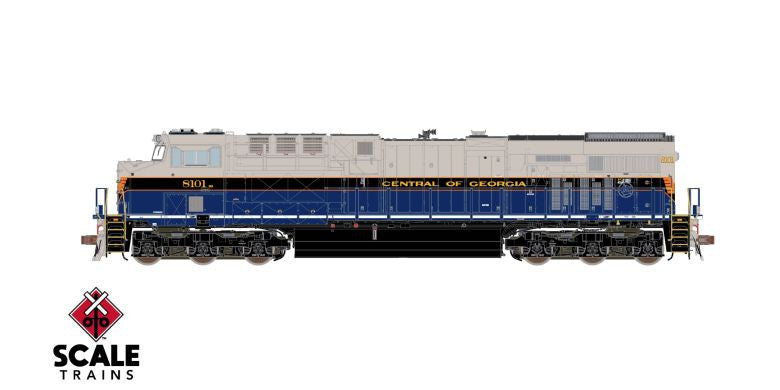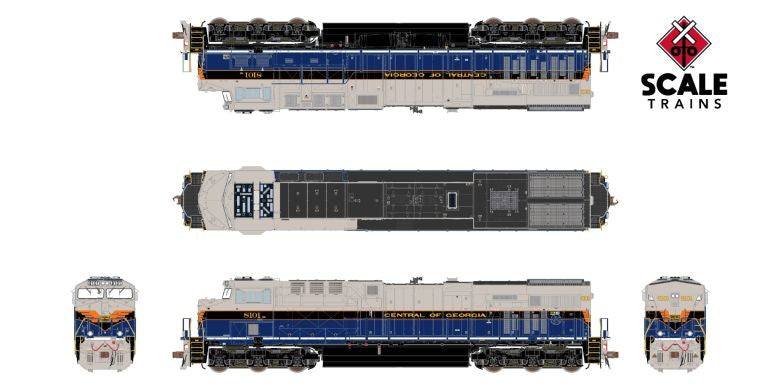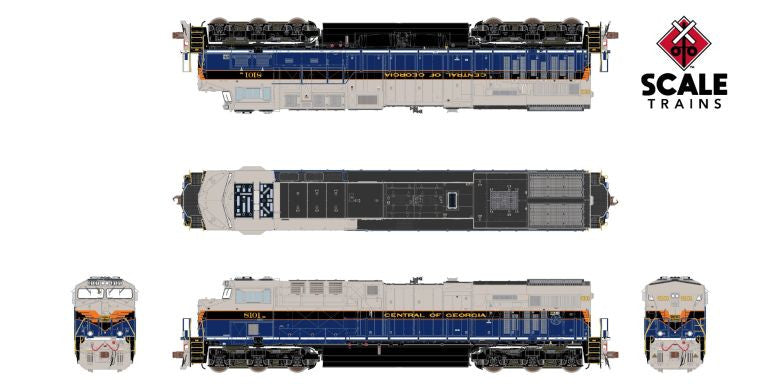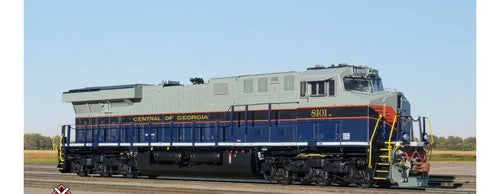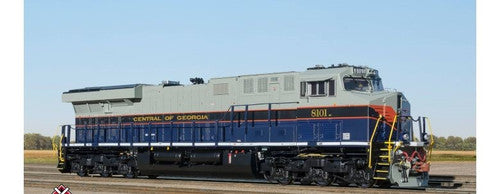ScaleTrains SXT33616 GE ES44AC, Norfolk Southern/Heritage/Central of Georgia #8101 DCC & Sound HO Scale
ScaleTrains SXT33616 GE ES44AC, Norfolk Southern/Heritage/Central of Georgia #8101 DCC & Sound HO Scale is backordered and will ship as soon as it is back in stock.
Couldn't load pickup availability
Delivery and Shipping
Delivery and Shipping
Add some general information about your delivery and shipping policies.
Description
Description
ScaleTrains Rivet Counter SXT33616 GE ES44AC, Norfolk Southern/Heritage/Central of Georgia #8101 DCC & Sound HO Scale (Note pictures may show a different road number).
In 2002, GE introduced the “Evolution Series” of locomotives. Better known as GEVo or ES44, this series has become the best-selling line of diesel locomotives of all time with production nearing 8,000 units.
Each Operator HO Scale GE ES44 roadname shares a common cab and long hood configuration. To maximize pulling power, the Operator ES44 utilizes the same motor and drivetrain as its top-of-the-line Rivet Counter series counterpart. The Operator HO ES44 is available DC/DCC with 21-pin connector or with ESU LokSound 5 DCC & sound pre-installed at the factory.
Road Number Specific ScaleTrains
- Era: 2016 to Present
- NS Series 8091 to 8140, built 1-3/12
- Road number 8100
- Central of Georgia Railway heritage paint scheme
- Fully-assembled
- Operating LED ground lights on both sides of locomotive*
- Operating LED front, rear and rectangle side walkway lights*
- Operating LED front and rear deck-mounted alternating ditch lights**
- Printed and LED lighted number boards*
- LSL (Locomotive Speed Limiter) indicator lights on cab sides (non-operating)
- Sill-mounted brake stick holder
- Semi-scale coupler buffers equipped with die-cast metal semi-scale Type E knuckle couplers
- Single trainline hose with silver gladhand
- Pilot-mounted battery charging receptacles
- Front dummy Multiple Unit (MU) receptacles mounted to pilot face
- Front and rear raised pilot-mounted Multiple Unit (MU) receptacles
- Front and rear single ECP brake equipment box and cable mounted on pilot face
- See-through round-hole stepwell steps
- Walkway with front anticlimber; no support brackets
- GE “nub” pattern walkway tread
- Late handrails with U-bolt caps and narrow rear most stanchion on long side rails
- Wide profile end handrails
- Sand box clean out door with knuckle buster latch and hinge
- Front high (cab) mounted headlight
- Front straight grab irons mounted directly to the nose
- Front right side mounted narrow nose drop grab iron
- Right nose door without window
- Front high-mounted (cab) numberboard housings
- Dual cab side blue flag holder
- Left side under cab front access bolted X panel; rear door with square corrugated grille
- Late cab with barrel bolt latches on subbase doors
- Detailed cab interior with separate floor, rear wall, seats, and control stand
- In cab grade crossing camera mounted on right side
- Tinted cab side windows
- Tall mirror mounted in front of sliding cab side windows on both sides; additional small mirror on right side
- Cab roof JEM Communications PTC antenna farm with single large Sinclair antenna
- Small bolted and hinged inverter cabinet door
- See-through dynamic brake exhaust
- Left side dynamic brake cab: tri blower dynamic brake with flush exhaust
- Etched metal see-through dynamic brake intake grilles with blower motors visible inside
- Right side dynamic brake cab: door with grille, small grille, door with grille, and door with grille
- Dynamic brake cab door with high door handle and high mounted door handle bumper
- Short right side air intake grille
- Left side auxiliary cab: 3 tall doors with latches on the #2 door and long auxiliary cab filter box door
- Right side auxiliary cab: 4 doors with latches on #1 and #4 doors
- ES44 style engine cab doors: latched first door in each set of three
- Three engine cab roof lift rings
- Lost wax brass cast Nathan AirChime K5HLR2 horn mounted on engine cab roof
- Separate exhaust stack
- Left side exhaust cab doors: latched last door in set of three
- Flush heat exchanger housing with two piece wide slot grille
- Raised radiator grille
- 22 individually applied etched metal see-through radiator intake and exhaust grilles on sides and top of radiator compartment
- Left side radiator cab grille arrangement: Raised doors. Grilles - tall-short-tall-short-tall, no grille under brake wheel short front angled grille and two-piece rear angled grille
- Right side radiator cab grille arrangement: Raised doors. Grilles – tall, short, tall, tall, short, tall, short, tall, short front angled grill, two-piece rear angled grille
- Flat water fill box with sight glass
- High mounted horizontal rear headlight
- Rear anticlimber without support brackets
- Rear wide-spaced dual dummy Multiple Unit (MU) receptacles
- Accurately profiled frame with separately applied plumbing and cabling
- GE Hi-Ad trucks with capped electric parking brake mounting brackets on right front and left rear side frames and separately applied brake cylinders, air plumbing, and rotating bearing caps
- Triangular handbrake chain bracket
- Toilet drain with interior handle
- AEI tag mounted on bracket below the right sidesill
- Dual Graham-White (Prime) finned 075 air filters
- Graham-White 994-500 air dryer
- 5,300-gallon fuel tank with internal waste retention tank, digital fuel gauge, vertical fuel gauge, and round fuel gauge
- Dual fuel fills per side with rear fill “blanked”
- Angled top left side fuel tank top box
- Short crankcase drainpipe
- Factory-applied wire grab irons, snowplow with grab irons, spare knuckles, trainline hoses with silver gladhands, 3-hose MU clusters with silver gladhands, uncoupling levers, windshield wipers, mirrors, sunshades, air tanks, fuel tank mounted electronic bell, brake wheel, and more
- Motor with 5-pole skew wound armature
- Dual flywheels
- All-wheel drive
- All-wheel electrical pick-up
- Directional LED headlights
- Printing and lettering legible under magnification
- Operates on Code 70, 83, and 100 rail
- Packaging safely stores model
- Minimum Radius: 18”
- Recommended Radius: 22”
DCC & sound equipped locomotives also feature:
- ESU-LokSound 5 DCC and Sound decoder with “Full Throttle”
- Two (2) cube-type speakers
- Accurate GEVO-12 prime mover and auxiliary sounds, horn, bell, and more
- ESU-designed PowerPack with two (2) super capacitors***
- Operates on both DC and DCC layouts
* Lighting features operate when using an ESU decoder with appropriate programming while operating using DCC
** During DC operation, class lights illuminate in white. Access to other colors and the ability to change colors requires an ESU DCC decoder while operating in DCC
*** Compatible with appropriately programmed ESU decoders while operating using DCC
In 2002, GE released the first GEVo, a new series of locomotives that would replace the AC4400CW and Dash 9-44CW. The first two models were the ES44DC and ES44AC. The ES44C4 followed a few years later.
The new models were designed to meet the stricter diesel locomotive emissions standards imposed by Environmental Protection Agency (EPA) regulations. The EPA “Tier” emissions standards are a series, or Tiers, of allowable emissions levels based upon a locomotive’s date of manufacture. In 2005, Tier 2 took effect followed by Tier 3 in 2010 and Tier 4 took in 2015.
GE developed a new diesel engine, the 12-cylinder GEVO 12, to meet the new emission standards. Both the bore and stroke were increased to produce the same 4,400 horsepower as the older 7FDL16 16-cylinder engine.
The new prime mover drives an alternator producing AC current that is rectified to DC current. On the ES44DC, this powers the traction motors. On the ES44AC and ES44C4, the DC current is “chopped” back into AC to power the traction motors. The two models share a common 73’ 2” frame and external appearance.
The external appearance is similar to the AC4400CW. In fact, the cab on early ES44s is almost identical. In 2009, GE changed the cab and nose, moving the nose door from the left side to the right side and replacing the curve seams with more square seams.
Unlike their predecessors, both the AC and DC versions of the ES44 have the large box behind the cab. The biggest visual difference is the larger “wing” structure over the radiator cab. The thicker radiators and related equipment in the radiator cab work to cool the exhaust, which reduces emissions.
Customer options and design changes have resulted in seven different dynamic brake configurations. The grilles on the sides of the radiator cab have also gone through seven configurations. The most recent units have changed the latches on the engine cab doors to match the ET44 units.
Although EPA Tier 4 standards went into effect in 2015, the ES44-series continue to be built. This is due to the Tier 4 Credits, a complicated system that allows GE to continue to build and various railroads to buy the ES44 based on the number of Tier 4 units built.
After 2 testbed units and 35 pre-production units, over 7,600 additional ES44s have been built. All of the major railroads including BNSF, Canadian National, Canadian Pacific, CSX, Norfolk Southern, and Union Pacific have fleets with 100s of units. Florida East Coast, Ferromex, Iowa Interstate, and Kansas City Southern also operate ES44s. In addition, 131 were built as lease units for Citirail.
The ES44 has become the best-selling diesel locomotive of all time.
